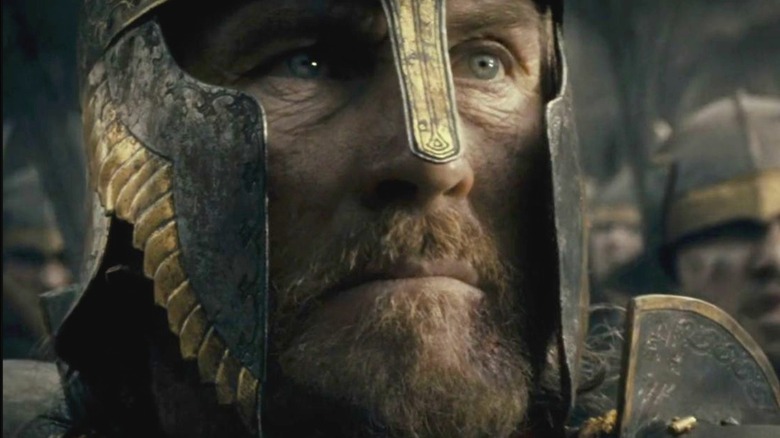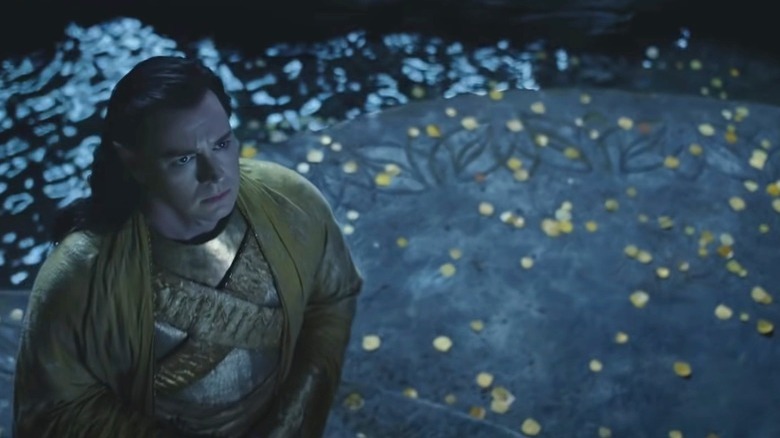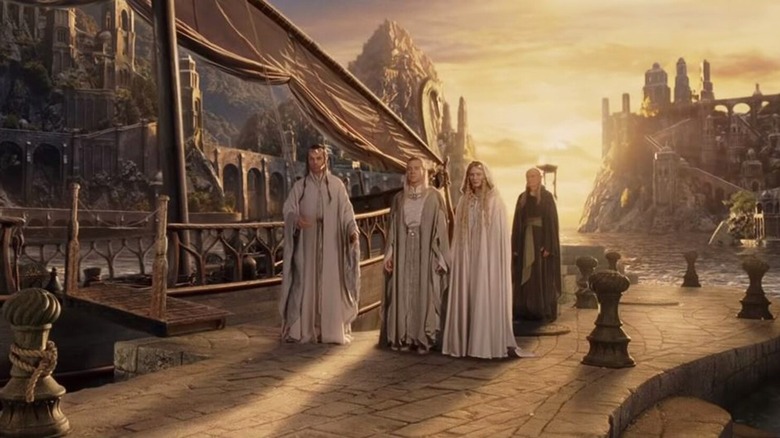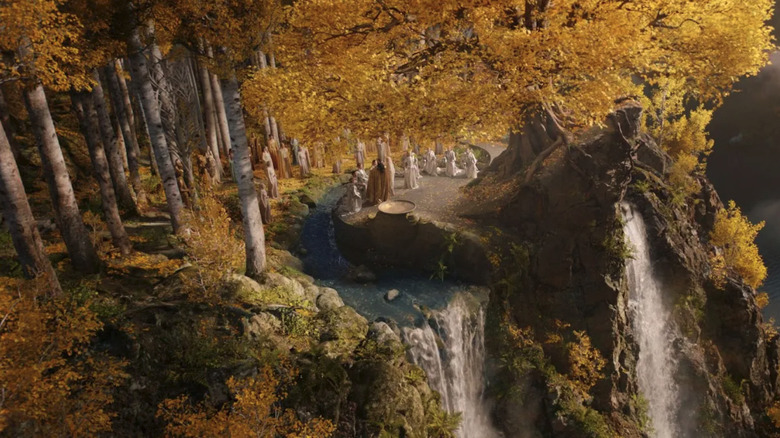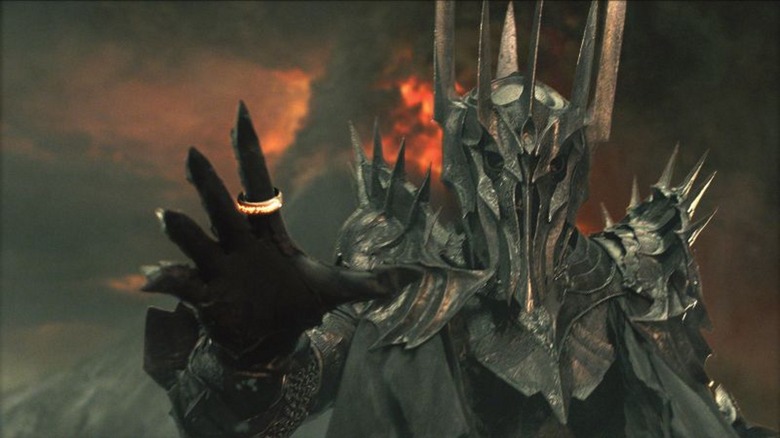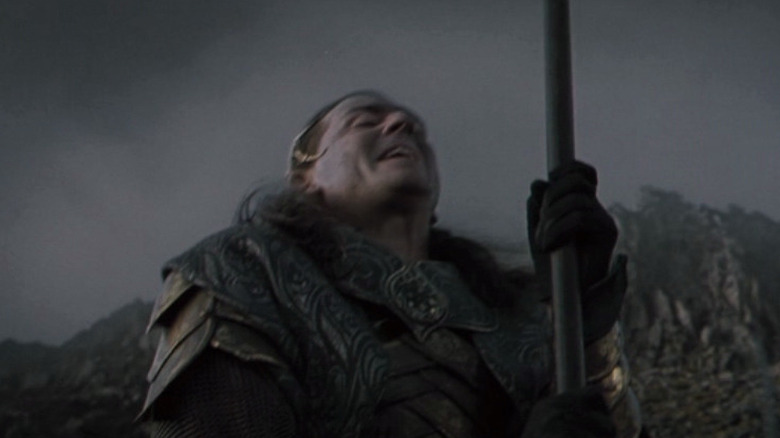Lord Of The Rings' Gil-Galad Explained
Amazon Studios' Middle-earth series, "The Rings of Power," officially got its first trailer during the Super Bowl — and it reveals a ton of new details about the show. We learn more about Harfoots, the ancestors of hobbits. We see the island kingdom of Númenor for the first time. And of course, we get plenty of sweeping, Peter Jackson-esque shots of many new areas of Middle-earth.
There are also several new and mysterious elements, like the man in the fire, the mysterious wanderers, and a strange, unidentified monster never seen before in Middle-earth cinema.
For a brief moment, we also see a somber Elf dressed in gold, looking up in concern as a flaming ball of fire streaks across the sky. This man, played by Benjamin Walker ("The Choice," "In the Heart of the Sea"), has been confirmed to be the Elven lord Gil-galad. Fans of the movies have (almost) never seen Gil-galad on-screen before, and those who have read "The Lord of the Rings" have only heard him mentioned in passing.
However, if you dig into the appendices and other areas of Tolkien's writings, it quickly becomes clear that Gil-galad is a critical character, particularly during the Second Age, the setting for the show. Even so, Gil-galad doesn't figure prominently in any of Tolkien's stories, and cobbling together a coherent version of his life takes a bit of work. So let's dive into it, shall we?
Gil-galad was an Elven king
"Gil-galad was an Elven-king./ Of him the harpers sadly sing:/ the last whose realm was fair and free/ between the Mountains and the Sea." These poetic words, which are part of an epic poem called "The Fall of Gil-galad," are recited by Samwise Gamgee in the "Fellowship of the Ring" book as the hobbits and Strider approach the hill of Weathertop. The fact that a hobbit would know who Gil-galad is shows that the Elven lord is important. After all, at that point in Middle-earth history, they're singing about him 3,000 years after his death.
But Gil-galad's sad story isn't a heartbreaker from beginning to end. It has plenty of ups and downs along the way. He is eventually recognized as the High King of the faction of Elves called the Ñoldor. In fact, he's the fourth and final Elf to hold that title (via Tolkien Gateway). At some point along the way, he also picks up the nickname Gil-galad, which "The Silmarillion" tells us means "Star of Radiance."
It's also worth mentioning that while it sounds pretty cool, the "High King" moniker represents different levels of authority over the disunited Ñoldor at different times in Middle-earth history. So even though he's a "high king," Gil-galad predominantly rules over his own kingdom of Lindon in northwestern Middle-earth for most of his life after he inherits his title late in the First Age.
Gil-galad stays in Middle-earth
Gil-galad's decision to rule a kingdom in Middle-earth is kind of a big deal. At the end of the First Age, some of the Elves are given the option to return to the Blessed Realm, and many of them take the offer. But some of them — including Celeborn, Galadriel, and Gil-galad — decide to stay behind and seek their own fortunes on the untamed continent of Middle-earth. In "The Silmarillion," we find out that Gil-galad has a helpful second in command by his side throughout this process. Elrond, who is still pretty young at this point, also stays in Middle-earth and helps the High King set up his kingdom.
It's interesting to note that, long after Lindon and Gil-galad become ancient history, the remnant of the High King's people continue to dwell on the coasts of Middle-earth for thousands of years, just west of the area that eventually becomes known as the Shire. They're led by another famous Elven lord, Círdan the Shipwright, and it's part of their ancestral home that Frodo, Bilbo, and the hobbits see when they arrive at the Grey Havens at the end of "The Return of the King" (via Tolkien Gateway).
So as the Second Age begins, Gil-galad finds himself heading up the kingdom of Lindon in a Middle-earth that is taking a deep breath after the downfall of the first Dark Lord, Melkor.
Gil-galad remains involved on the edges of the main Middle-earth story
As the age unfolds, it becomes clear that Melkor's own second in command, Sauron, is becoming a new threat. However, for thousands of years, Gil-galad doesn't personally get involved in the fighting much as the Second Age plays out. Nevertheless, he remains close on the edge of the story.
For instance, when Sauron arrives in the area disguised as Annatar, the Lord of Gifts, Gil-galad and Elrond are among the few who recognize that the mysterious stranger is a threat. Later, when Sauron starts a war over the Rings of Power, Gil-galad sends an army, commanded by Elrond, to help. He's also given two of the Three Elven Rings, which he eventually passes along to new keepers.
Most of the time that Gil-galad comes up in the text, though, it's with the Númenóreans. He becomes good friends with the Númenórean king Tar-Aldarion early in the age. Toward the end of the age, after Númenor is destroyed and its survivors set up the kingdoms of Gondor and Arnor, Gil-galad becomes besties with their leader, Elendil. He even builds Elendil some towers in his new northern kingdom as a kind of welcoming gift.
Throughout all this activity, Gil-galad remains on the periphery of the story. However, as the age comes to a close, Sauron reappears in Mordor and begins attacking the Númenórean exiles, sparking the events known as the War of the Last Alliance.
Sauron gets his hands on Gil-galad
After spending the bulk of his career out of the limelight, Gil-gilad finally gets into the trenches in the War of the Last Alliance — and we quickly see why he was wise to avoid that move in the first place. After all, when you have a song about you called "The Fall of Gil-galad," you know things aren't going to end well.
When Gil-galad and the Númenóreans realize that Sauron is back, they form the Last Alliance. This alliance is primarily led by Elendil, the High King of the Dúnedain, and the Eleven High King Gil-galad himself. It takes them a few years to get going, but once the group gets to Mordor, it isn't long before things get real.
There's an epic showdown in front of the Black Gate called the Battle of Dagorlad (via Tolkien Gateway). After that, the Alliance enters Mordor and besieges Sauron in his tower of Barad-dûr. When things get really desperate, Sauron finally comes out to fight, and it's there, on the brink of victory, that Gil-galad finally meets his doom
Connecting the new to the old
When you put it all together, Gil-galad's story arc is about as epic as they come. He's born during the reign of the first Dark Lord, Melkor, he becomes the High King of the Ñoldor at the end of the First Age, and then he spends the entire Second Age ruling the powerful Elven kingdom of Lindon.
Gil-galad's story isn't just epic, though. It also fits perfectly into the timeline that Amazon wants to cover for the show. While the showrunners have confirmed that they are condensing the storyline, the stories that they're including in their new adaptation almost perfectly start and end with Gil-galad's lifetime.
Along with the continuity that Gil-galad can bring to the series, the show has also clearly made an effort to connect the Gil-galad of "The Rings of Power" with the one who shows up for an instant in Peter Jackson's "The Fellowship of the Ring." In fact, Vanity Fair was the first to point out that the original iteration of the character, played by Mark Ferguson, "bears a striking resemblance" to the new version of Gil-galad brought to life via Benjamin Walker.
While the connections are there, it remains to be seen if Amazon can stick the landing when it comes to bringing Gil-galad's story (and a condensed version, at that) to life on the streaming screen. It's a tall order, to be sure, the success or failure of which will be judged in the coming years.
